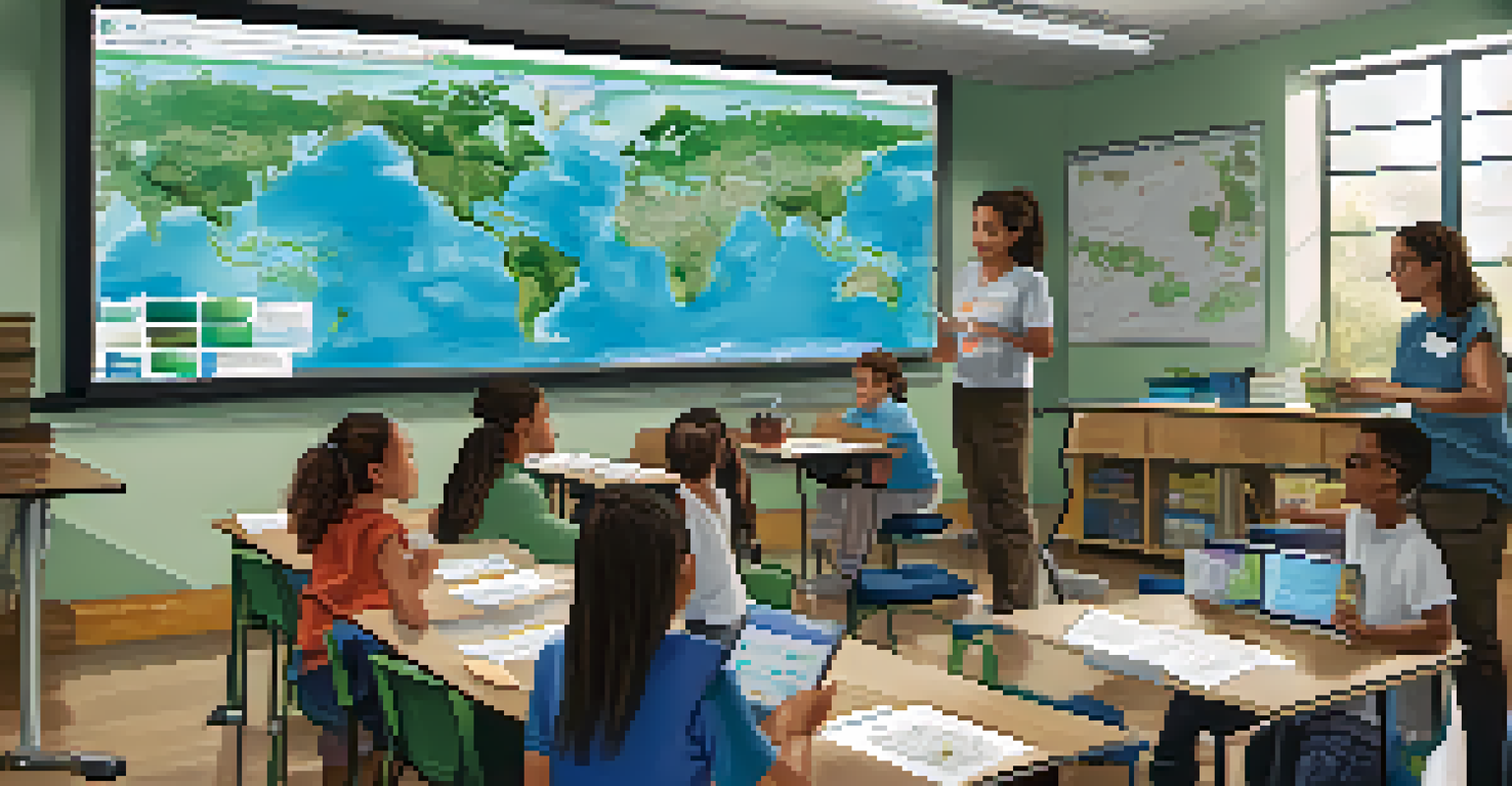Project-Based Learning and Environmental Education

Understanding Project-Based Learning (PBL)
Project-Based Learning, or PBL, is an educational approach that encourages students to explore real-world problems and challenges. Unlike traditional learning, where students often memorize facts, PBL focuses on engaging them in projects that require critical thinking and collaboration. For instance, students might work together to design a sustainable community garden, addressing both environmental issues and social needs.
Education is not the filling of a pail, but the lighting of a fire.
One of the key benefits of PBL is its ability to foster deeper understanding. By working on a tangible project, students can see the relevance of their studies in action. This hands-on approach not only makes learning more enjoyable but also helps students retain information more effectively than rote memorization.
Moreover, PBL promotes essential skills like teamwork, communication, and problem-solving. These skills are increasingly important in today’s job market, as employers seek individuals who can think critically and collaborate effectively. Thus, integrating PBL into the curriculum can prepare students for future success in both academic and professional settings.
The Role of Environmental Education
Environmental education is crucial in helping students understand and appreciate the natural world. It teaches students about ecosystems, sustainability, and the impact of human activities on the environment. This knowledge empowers them to make informed decisions and take action to protect our planet.

Incorporating environmental education into PBL allows students to tackle pressing ecological issues directly. For example, a project might involve researching local water quality and developing strategies to improve it. This not only raises awareness about environmental challenges but also encourages a sense of responsibility among students.
PBL Enhances Real-World Learning
Project-Based Learning engages students in real-world issues, fostering critical thinking and collaboration.
Furthermore, environmental education fosters a connection to nature, which is essential for nurturing future stewards of the Earth. When students engage with their environment, whether through field trips or community projects, they develop a personal investment in conservation efforts. This emotional connection can lead to lifelong commitment to environmental stewardship.
Benefits of Combining PBL with Environmental Education
Combining Project-Based Learning with environmental education creates a powerful synergy that enhances both teaching and learning. This approach encourages students to engage actively with environmental issues, leading to a deeper understanding of complex topics. For example, students might investigate the effects of plastic pollution in their community, turning their findings into a campaign for change.
The greatest threat to our planet is the belief that someone else will save it.
Additionally, this combination cultivates a sense of agency among students. When they work on projects that have real-world impact, they realize that their actions can lead to significant change. This sense of empowerment is crucial for motivating young people to take ownership of environmental issues and pursue solutions.
Moreover, this integrated approach helps students develop a multidisciplinary perspective. They apply knowledge from science, social studies, and even ethics as they navigate their projects, reinforcing the idea that environmental problems are interconnected. This holistic view is essential for tackling the complex challenges of the modern world.
Examples of PBL in Environmental Education
There are countless examples of successful Project-Based Learning initiatives in the realm of environmental education. One inspiring case is a school that created a waste reduction program. Students conducted waste audits, learned about recycling, and developed campaigns to reduce waste in their school, all while gaining valuable insights into sustainability.
Another example is students who partnered with local organizations to restore a nearby wetland. They researched local wildlife, designed educational materials for the community, and participated in hands-on restoration activities. This project not only enriched their learning experience but also strengthened community ties and fostered environmental awareness.
Environmental Education Empowers Students
Integrating environmental education into PBL cultivates a sense of responsibility and connection to nature.
These projects demonstrate how PBL can transform students into active participants in environmental conservation. By engaging with real-world issues, students gain practical skills and a sense of purpose that traditional learning often lacks. They become advocates for change, inspiring their peers and community members to take action.
Challenges in Implementing PBL for Environmental Education
While the benefits of combining PBL and environmental education are clear, there are challenges in implementation. One common hurdle is curriculum constraints, as educators often feel pressured to cover specific content within a limited timeframe. This can make it difficult to dedicate sufficient time to in-depth projects that require exploration and experimentation.
Another challenge is the need for teacher training and resources. Educators must be comfortable with facilitating student-led projects, which can be a shift from traditional teaching methods. Providing professional development and access to materials is essential for empowering teachers to embrace this approach.
Lastly, community engagement plays a crucial role in the success of PBL initiatives. Schools must build partnerships with local organizations, experts, and resources to provide meaningful experiences for students. This collaboration can sometimes be challenging to establish, but it is vital for creating impactful projects.
Strategies for Effective PBL in Environmental Education
To effectively implement PBL in environmental education, educators can start by identifying relevant local issues. By connecting projects to the community, students can see the real-world implications of their work. For instance, studying air quality in their town can lead to actionable solutions that benefit their immediate environment.
Another strategy is to incorporate technology into projects. Utilizing tools like GIS mapping or data analysis software can enhance students' research capabilities and engagement. Technology can help students visualize complex environmental data, making their findings more accessible and impactful.
Challenges in PBL Implementation
Curriculum constraints, teacher training needs, and community engagement pose challenges in implementing PBL effectively.
Lastly, fostering a reflective learning environment is crucial. Encouraging students to discuss their experiences, challenges, and successes not only deepens their understanding but also allows for continuous improvement. This reflective practice cultivates a growth mindset, essential for navigating future projects and challenges.
Future of PBL and Environmental Education
The future of Project-Based Learning and environmental education looks promising, with increasing recognition of their importance. As educational systems evolve, there is a growing emphasis on experiential learning and critical thinking skills. This shift aligns perfectly with the goals of PBL, making it an ideal approach for modern education.
Moreover, the urgency of environmental issues, such as climate change and biodiversity loss, makes the integration of these fields even more relevant. Schools are beginning to adopt curricula that prioritize sustainability and environmental literacy, ensuring that students are equipped to tackle these challenges head-on.

In conclusion, the combination of Project-Based Learning and environmental education not only enhances student engagement but also prepares the next generation of environmental stewards. By embracing this approach, educators can inspire students to take meaningful action and contribute positively to the world around them.